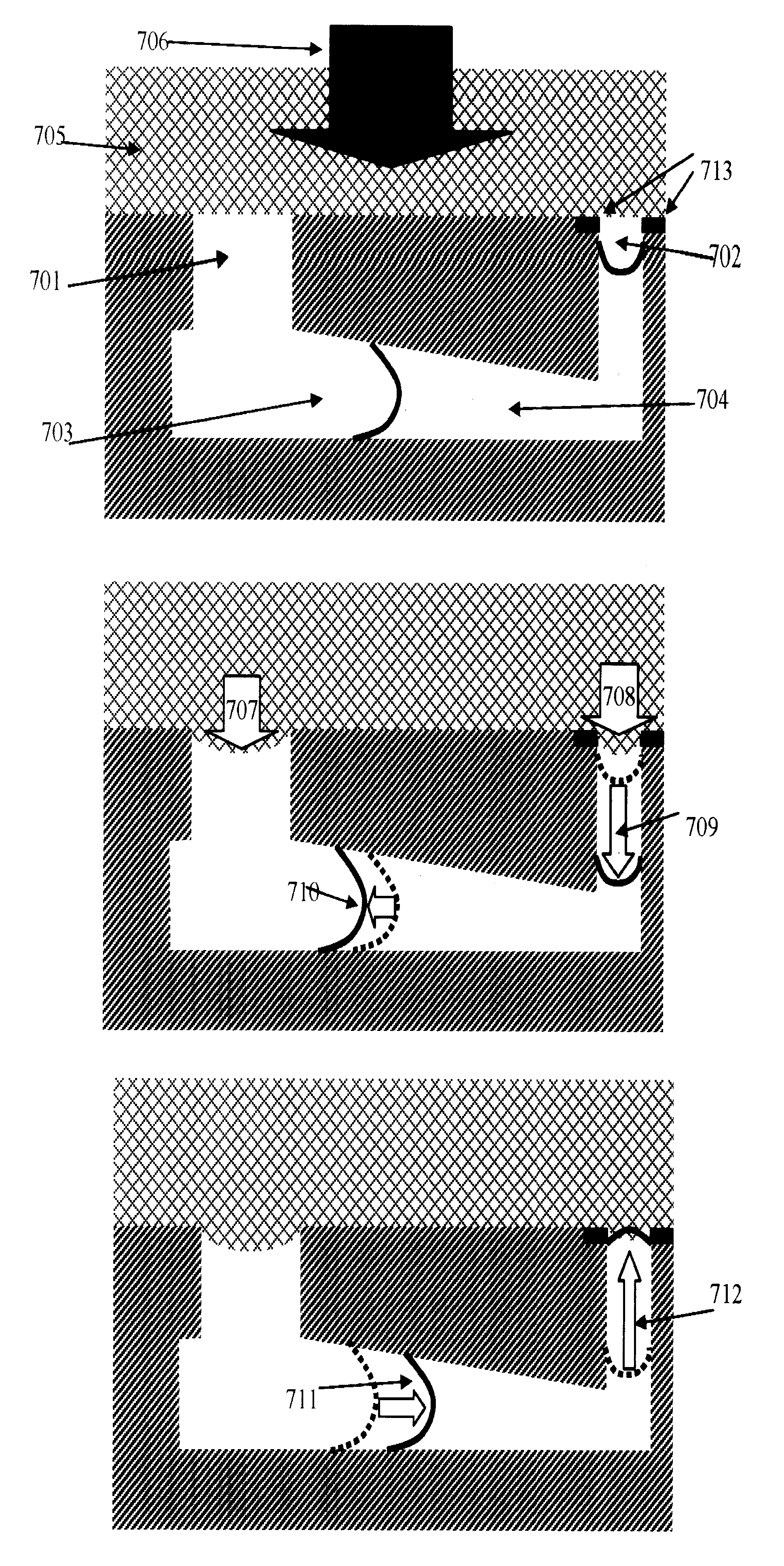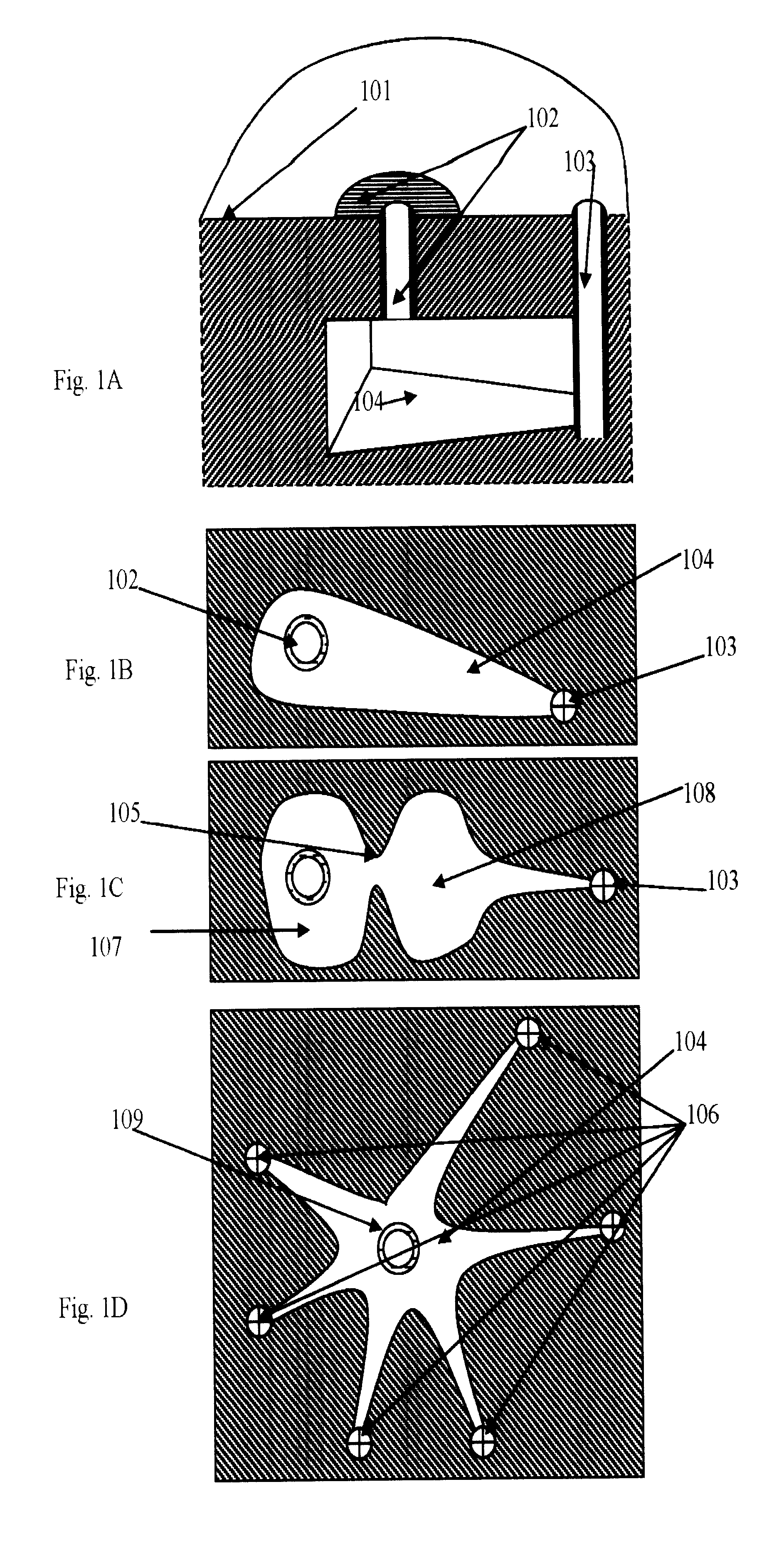Components for nano-scale Reactor
a nano-scale reactor and component technology, applied in the field of microfluidics, can solve the problems of complex manufacturing process, general restriction on the type of processing type acceptable, and complex packaging of said devices, and achieve the effects of reducing the evaporation rate of solvent, reducing the cross-section area, and reducing the intensity of electric field
- Summary
- Abstract
- Description
- Claims
- Application Information
AI Technical Summary
Benefits of technology
Problems solved by technology
Method used
Image
Examples
example 2
[0078] FIG. 18 illustrates yet another design of microfluidic storage device that employs array of microfluidic storage devices. This array manufactured using process described in previous example. On dispensing surface of the plate plurality of groves were created using etching or micromachining processes. These groves then filled with porous hydrophilic material 1803 (silicon oxide in this example). On top of this thin layer of hydrophobic material 1804 (sputtering of aluminum can be used) was deposited using photo mask to preserve plurality of open segments 1805.
[0079] Operation of this device are identical to one described in the previous example, except that volume of porous material 1803 is saturated with water. This design creates artificial area with high vapor pressure around open ports and contains significant supply of liquid solvent. In this example total volume of adsorbed water is 1 milliliter, and dry out time for the array is increased to 36 hours.
[0080] This storage...
example 3
[0083] This example describes devices identical to ones disclosed in previous two examples with one exceptional feature. These devices do not contain dedicated intake port, but rather singe port and intake area surrounding it. Materials and manufacturing process for these devices remain unchanged from previous two samples, but method of their use changes.
[0084] Said devices are disposed in atmosphere of helium and special steps could be taken to desorb residual gases or other weekly adsorbed liquids from devices. Liquid is then disposed on available ports and device is removed from helium environment.
[0085] Considering dimensions of the example 1, helium diffuses away from said cavity and liquid is completely pooled inside the cavity in less then 15 seconds.
[0086] Micro-Contact Liquid Dispenser
[0087] Apparatus has a flat planar surface with several channels. At least one channel has a cross-section area distinct from others. Channels are connected inside the body of the apparatus. S...
example 4
[0109] Device on FIG. 13 has polystyrene walls (contact angle 840) 1001 and 1002. Cavity 1003 has FEP walls (contact angle 1110). Diameter of part 1001 is 0.4 micrometer and diameter of part 1002 is 0.2 micrometer. Thickness of cavity 1003 is 0.2 micrometer in the center and 0.25 micrometer total. Gas pressure in volume 1002 is 10 KPa. Liquid 1301 is water at temperature 300 K.
[0110] Differential pressure required for liquid to pass cavity 1003 is 0.5 MPa. This pressure creates meniscus 1304 with curvature radius 1.9 microns and meniscus 1305 with curvature radius 0.28 microns. Formation of micro droplet 1302 allocates 3.4 attoliters and has 14.5 microns curvature radius of lower surface 1303. This significant reduction of pressure in volume 1307 causes redistribution of liquid from area 1306 that results in formation of meniscus 1308.
PUM
| Property | Measurement | Unit |
|---|---|---|
| Length | aaaaa | aaaaa |
| Fraction | aaaaa | aaaaa |
| Fraction | aaaaa | aaaaa |
Abstract
Description
Claims
Application Information
 Login to View More
Login to View More - R&D
- Intellectual Property
- Life Sciences
- Materials
- Tech Scout
- Unparalleled Data Quality
- Higher Quality Content
- 60% Fewer Hallucinations
Browse by: Latest US Patents, China's latest patents, Technical Efficacy Thesaurus, Application Domain, Technology Topic, Popular Technical Reports.
© 2025 PatSnap. All rights reserved.Legal|Privacy policy|Modern Slavery Act Transparency Statement|Sitemap|About US| Contact US: help@patsnap.com



